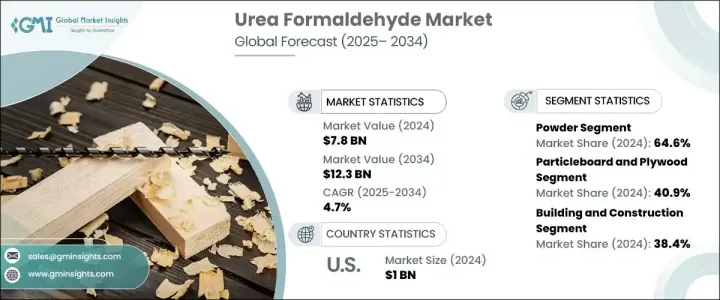PUBLISHER: Global Market Insights Inc. | PRODUCT CODE: 1716488

PUBLISHER: Global Market Insights Inc. | PRODUCT CODE: 1716488
Urea Formaldehyde Market Opportunity, Growth Drivers, Industry Trend Analysis, and Forecast 2025 - 2034
The Global Urea Formaldehyde Market reached USD 7.8 billion in 2024 and is projected to expand at a CAGR of 4.7% from 2025 to 2034. The market's growth is fueled by the material's exceptional adhesive strength, affordability, and versatility, making it a key component in various industrial applications. Urea formaldehyde continues to gain momentum as industries seek cost-efficient, high-performance bonding agents that meet stringent production demands. The rising focus on durable materials, coupled with the need for efficient manufacturing solutions, is pushing the adoption of urea formaldehyde in engineered wood and other composite products. Its easy storage and handling, alongside superior bonding characteristics, contribute to its growing preference among manufacturers aiming to improve production output without compromising on quality. Moreover, as industries shift toward materials that balance performance and cost, urea formaldehyde maintains a competitive edge, further supporting its sustained demand worldwide.

In terms of form, the market is segmented into powder and liquid, with powdered urea formaldehyde capturing a significant 64.6% share in 2024. The powdered variant continues to dominate due to its longer shelf life, ease of transportation, and operational cost advantages over the liquid type. Its inherent stability and efficiency make it suitable for large-scale manufacturing, especially where high-quality, durable end products are critical. The reduced processing challenges and longer usability period of the powdered form offer manufacturers greater flexibility in production schedules, thereby enhancing its attractiveness in the marketplace.
| Market Scope | |
|---|---|
| Start Year | 2024 |
| Forecast Year | 2025-2034 |
| Start Value | $7.8 Billion |
| Forecast Value | $12.3 Billion |
| CAGR | 4.7% |
On the application side, urea formaldehyde finds extensive usage in areas that require superior bonding and curing properties. The particleboard and plywood segment accounted for 40.9% of the total market share in 2024, underscoring the material's importance as a core adhesive in engineered wood production. Its quick setting time and ability to provide strong, durable bonds enable manufacturers to meet increasing demands for high-quality wood composites. Urea formaldehyde's role as a reliable adhesive solution continues to support efficient production processes, helping companies maintain output standards while optimizing costs. Its widespread use in creating robust composite products reflects the material's indispensable role in modern manufacturing.
In regional terms, the U.S. urea formaldehyde market was valued at USD 1 billion in 2024, with demand largely driven by the rising use of engineered wood in construction and remodeling activities. Growth in the housing sector, alongside increasing renovation projects, continues to bolster the market as manufacturers respond to the need for sturdy and affordable bonding solutions. The focus on durable, cost-effective materials is expected to sustain urea formaldehyde's growth trajectory across North America.
Table of Contents
Chapter 1 Methodology & Scope
- 1.1 Market scope & definition
- 1.2 Base estimates & calculations
- 1.3 Forecast calculation
- 1.4 Data sources
- 1.4.1 Primary
- 1.4.2 Secondary
- 1.4.2.1 Paid sources
- 1.4.2.2 Public sources
- 1.5 Primary research and validation
- 1.5.1 Primary sources
- 1.5.2 Data mining sources
Chapter 2 Executive Summary
- 2.1 Industry synopsis, 2021-2034
Chapter 3 Industry Insights
- 3.1 Industry ecosystem analysis
- 3.1.1 Factor affecting the value chain
- 3.1.2 Profit margin analysis
- 3.1.3 Disruptions
- 3.1.4 Future outlook
- 3.1.5 Manufacturers
- 3.1.6 Distributors
- 3.2 Supplier landscape
- 3.3 Profit margin analysis
- 3.4 Key news & initiatives
- 3.5 Regulatory landscape
- 3.6 Impact forces
- 3.6.1 Growth drivers
- 3.6.1.1 Increasing construction activities, driven by urbanization and infrastructure development projects
- 3.6.1.2 Expansion of furniture sector
- 3.6.1.3 Rising awareness of environmental sustainability
- 3.6.1.4 Increasing demand for textile finishes
- 3.6.2 Industry pitfalls & challenges
- 3.6.2.1 Competition from alternative materials
- 3.6.2.2 Associated health risks such as respiratory irritation and potential carcinogenicity
- 3.6.1 Growth drivers
- 3.7 Growth potential analysis
- 3.8 Porter's analysis
- 3.9 PESTEL analysis
Chapter 4 Competitive Landscape, 2024
- 4.1 Introduction
- 4.2 Company market share analysis
- 4.3 Competitive positioning matrix
- 4.4 Strategic outlook matrix
Chapter 5 Market Estimates and Forecast, By Form, 2021–2034 (USD Billion) (Kilo Tons)
- 5.1 Key trends
- 5.2 Powder
- 5.3 Liquid
Chapter 6 Market Estimates and Forecast, By Application, 2021–2034 (USD Billion) (Kilo Tons)
- 6.1 Key trends
- 6.2 Particleboard and plywood
- 6.3 Medium density fiberboard
- 6.4 Decorative laminates
- 6.5 Insulation materials
- 6.6 Textile finishing
- 6.7 Others
Chapter 7 Market Estimates and Forecast, By End Use Industry, 2021–2034 (USD Billion) (Kilo Tons)
- 7.1 Key trends
- 7.2 Automotive
- 7.3 Agriculture
- 7.4 Electrical appliances
- 7.5 Building and construction
- 7.6 Others
Chapter 8 Market Estimates and Forecast, By Region, 2021–2034 (USD Billion) (Kilo Tons)
- 8.1 Key trends
- 8.2 North America
- 8.2.1 U.S.
- 8.2.2 Canada
- 8.3 Europe
- 8.3.1 Germany
- 8.3.2 UK
- 8.3.3 France
- 8.3.4 Spain
- 8.3.5 Italy
- 8.3.6 Netherlands
- 8.4 Asia Pacific
- 8.4.1 China
- 8.4.2 India
- 8.4.3 Japan
- 8.4.4 Australia
- 8.4.5 South Korea
- 8.5 Latin America
- 8.5.1 Brazil
- 8.5.2 Mexico
- 8.5.3 Argentina
- 8.6 Middle East and Africa
- 8.6.1 Saudi Arabia
- 8.6.2 South Africa
- 8.6.3 UAE
Chapter 9 Company Profiles
- 9.1 Acron PJSC
- 9.2 ARCL Organics Ltd.
- 9.3 Asta Chemicals
- 9.4 Bakelite Synthetics
- 9.5 BASF SE
- 9.6 Biqem
- 9.7 Capital Resin Corporation
- 9.8 Hexion
- 9.9 LRBG Chemicals
- 9.10 Metadynea
- 9.11 Sadepan




